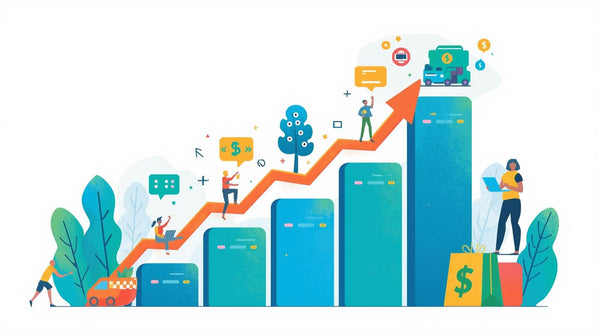Hello, this is Asim. I can help you with some tips on how to optimize your Shopify store for conversion.
Conversion rate optimization (CRO) is the process of improving your website’s user experience (UX) to encourage more visitors to buy your products or services. CRO can help you increase your sales, reduce your bounce rate, and boost your customer loyalty.
There are many factors that affect your Shopify store’s conversion rate, such as your site speed, design, layout, product descriptions, checkout process, and more. Here are some of the best practices that you can follow to optimize your Shopify store for conversion:
Improve your site speed:
Improving your Shopify store speed can have many benefits for your online business, such as enhancing your SEO, increasing your conversion rate, and improving your customer satisfaction. There are several factors that affect your store speed, some of which you can control and some of which you can’t. Here are some of the main factors that you can control and how to improve them:
- Apps: Apps can add functionality and features to your store, but they can also slow it down by adding extra code and requests. You should only install apps that are essential for your store and remove any unused or unnecessary apps. You should also check the app reviews and ratings to see if they have any impact on store speed. Some apps might have code that remains in your theme even after uninstalling them, so you should contact the app developers or hire a Shopify expert to help you remove any leftover code.
- Images: Images are important for showcasing your products and brand, but they can also take up a lot of space and bandwidth. You should optimize your images by compressing them, resizing them, and using the right format. The recommended image format size for Shopify is 4472 x 4472 px or 20 megapixels. You should also use JPG or PNG formats for most images, and SVG for logos and icons.
- Theme: Your theme determines the look and feel of your store, but it can also affect its speed. You should choose a theme that is responsive, lightweight, and well-coded. You should also avoid modifying your theme code too much, as this can introduce errors and conflicts. If you need to customize your theme, you should use the theme editor or hire a Shopify expert. You should also update your theme regularly to get the latest features and bug fixes.
These are some of the most effective ways to improve your Shopify store speed. However, you should always test and measure the impact of your changes using tools like Google Analytics, Lighthouse, or Shopify’s online store speed report. By doing so, you can identify what works best for your store and your customers, and continuously improve your store speed.
Highlight your product benefits:
Highlighting product benefits in Shopify is a way to showcase the value of your products and persuade your visitors to buy them. Product benefits are the positive outcomes or solutions that your products provide to your customers. For example, a product benefit of a pair of shoes could be comfort, durability, or style.
There are several ways to highlight product benefits in Shopify, such as:
- Using feature icons: Feature icons are visual elements that represent the benefits of your products. They can help you attract attention, convey information quickly, and create a professional look. You can use apps like Product Page Features Icons, Specify - Product Features, or Product Description Icons to add feature icons to your product pages.
- Writing engaging product descriptions: Product descriptions are the text that describes your products and their benefits. They can help you tell a story, appeal to emotions, and address pain points. You should use SEO keywords, bullet points, and emotional triggers to write engaging product descriptions. You can also use the Shopify Help Center to learn how to write product descriptions that sell.
- Using tabbed content: Tabbed content is a way to organize your product information into different sections or tabs. It can help you save space, improve readability, and highlight the most important benefits. You can use apps like Tabbed Content to add tabbed content to your product pages or any other pages.
Leverage personalization:
Personalization is the practice of tailoring online shopping experiences to individual customers based on their preferences, behavior, and demographics. It can help you increase your sales, reduce your bounce rate, and boost your customer loyalty.
There are many ways to leverage personalization in Shopify, such as:
- Using intelligent product-detail page recommendations: You can use apps like Personalized Recommendations or Limespot to show relevant products to your customers based on their browsing history, purchase history, and cart contents.
- Showing continuous shopping for returning customers: You can use apps like Persistent Cart or CartKit to save the items that your customers added to their carts across devices and sessions, and remind them to complete their purchase.
- Creating personalized bestseller lists to drive click-throughs: You can use apps like Bestsellers or [Instant Search +] to display the most popular products in your store or in a specific category, based on real-time sales data and customer behavior.
- Integrating user-generated content across your funnel: You can use apps like Loox or Stamped.io to collect and display customer reviews, ratings, photos, and videos on your product pages, homepage, and checkout page, and use them to create social proof and trust.
- Providing personalized delivery experience: You can use apps like Parcelify or Advanced Shipping Rules to offer customized shipping options and rates based on your customers’ location, cart value, weight, and other criteria.
- Using AI-powered chatbots: You can use apps like Tidio or Gobot to create conversational agents that can interact with your customers, answer their questions, provide product recommendations, and guide them through the purchase process.
Use social proof and trust signals:
Social proof and trust signals are ways to show your website visitors that your brand is trustworthy, reputable, and popular. They can help you increase your conversions, reduce your bounce rate, and boost your customer loyalty.
Social proof is the phenomenon where people tend to follow the actions or opinions of others, especially when they are uncertain or unfamiliar with a situation. Trust signals are elements that indicate the credibility and security of your website, such as logos, badges, certifications, and guarantees.
There are many ways to use social proof and trust signals on your website, such as:
- Displaying customer reviews, ratings, testimonials, and case studies: These are powerful forms of social proof that show how satisfied your previous customers are with your products or services. They can also provide useful information and feedback to your potential customers. You can use apps or plugins to collect and display customer reviews, ratings, testimonials, and case studies on your website, or use third-party platforms like Google My Business, Yelp, or Trustpilot.
- Showing social media followers, likes, shares, and comments: These are another form of social proof that show how popular and engaging your brand is on social media. They can also help you drive more traffic and exposure to your website. You can use widgets or buttons to display your social media followers, likes, shares, and comments on your website, or use tools like AddThis, ShareThis, or Sumo to create social media share buttons.
- Featuring logos of your clients, partners, awards, or media mentions: These are trust signals that show your authority and reputation in your industry or niche. They can also help you attract more customers who recognize and trust these logos. You can use images or icons to display the logos of your clients, partners, awards, or media mentions on your website, or use tools like Logo Showcase, Logo Slider, or Logo Carousel to create logo sliders or carousels.
- Providing guarantees, security logos, and trust seals: These are trust signals that show your commitment and responsibility to your customers. They can also help you reduce the risk and anxiety of your customers, especially during the checkout process. You can use text or images to display your guarantees, security logos, and trust seals on your website, or use tools like McAfee Secure, Norton Secured, or TrustBadge to add security logos and trust seals.
Optimize your checkout process:
The checkout process is the final and most important step in your conversion funnel. You want to make it as easy and smooth as possible for your customers to complete their purchase. To optimize your checkout process, you can use the following tips:
- Reduce the number of steps and fields required to complete the checkout
- Offer multiple payment options, including digital wallets and cryptocurrencies
- Provide free or discounted shipping and easy returns
- Display security logos and trust seals to assure your customers that their information is safe
- Use exit-intent popups, countdown timers, and scarcity tactics to create a sense of urgency and prevent cart abandonment.
These are some of the most effective ways to optimize your Shopify store for conversion. However, you should always test and measure the impact of your changes using tools like Google Analytics, Hotjar, or Omniconvert. By doing so, you can identify what works best for your store and your customers, and continuously improve your CRO strategy.
If you have any other questions, feel free to ask us.





0 comments